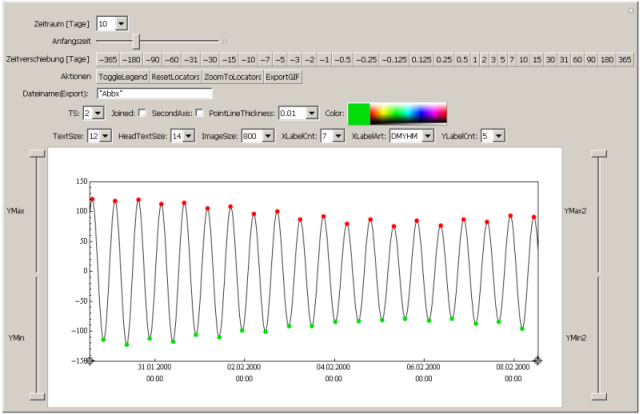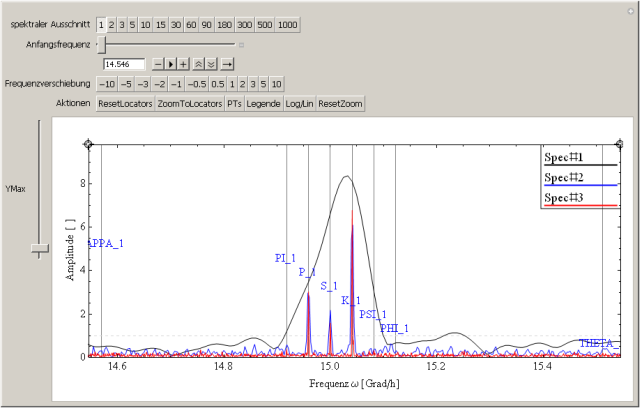Time Series Analyses with Mathematica: Difference between revisions
From BAWiki
imported>BAWiki 1 Created page with 'de: Zeitreihenanalyse mit Mathematica Für das Programm Mathematica ist im Laufe der Zeit eine Funktionssammlung (Stand Dez. 2009: 80 Funktionen) entstanden, die in Form eine…' |
imported>BAWiki 1 No edit summary |
||
| Line 2: | Line 2: | ||
Für das Programm Mathematica ist im Laufe der Zeit eine Funktionssammlung (Stand Dez. 2009: 80 Funktionen) entstanden, die in Form einer Bibliothek /eines Paketes in die Software eingebunden werden kann. Diese historisch gewachsene Funktionsbibliothek ist im Rahmen der Beweissicherung Elbe entstanden und wurde in der laufenden Projektarbeit aktualisiert und angepasst. Das Paket nutzt die Methoden der Version 7 von Mathematica und ist deshalb auch nur mit dieser Version vollständig einsetzbar. Folgende Themengebiete können den Funktionen zugeordnet werden: | Für das Programm Mathematica ist im Laufe der Zeit eine Funktionssammlung (Stand Dez. 2009: 80 Funktionen) entstanden, die in Form einer Bibliothek /eines Paketes in die Software eingebunden werden kann. Diese historisch gewachsene Funktionsbibliothek ist im Rahmen der Beweissicherung Elbe entstanden und wurde in der laufenden Projektarbeit aktualisiert und angepasst. Das Paket nutzt die Methoden der Version 7 von Mathematica und ist deshalb auch nur mit dieser Version vollständig einsetzbar. Folgende Themengebiete können den Funktionen zugeordnet werden: | ||
==Data Import / Export== | ==Data Import / Export== | ||
For data exchange with our own data format (BOE) the package provides import and export functions. Moreover Mathematica provides itself a lot of standard file formats and support SQL to access databases. | |||
==Time Series Functions== | ==Time Series Functions== | ||
There are a lot of functions doing the following: check time series, deliver meta-data about time series, extract parts of time series, calculates statistics and trends, doing interpolation, calculate mean time series, ... | |||
==Drawings / Figures== | ==Drawings / Figures== | ||
With the function TSListPlotArray figures can be build up which contains one or more time series. The function ListPlotSpektrum does the same but for spectral information. Both functions provide a lot of options for the design of figures. | |||
==Interactive Applications== | ==Interactive Applications== | ||
The functions TSListPlotArrayI and ListPlotSpektrumI build up an interactive application. Most of the options from the functions TSListPlotArray and ListPlotSpektrum can be manipulated interactively.<br/ > | |||
'''TSListPlotArrayI and the generated interactive application''' | |||
[[File:zeitreihe.png|none]] | |||
'''TSListPlotArrayI and the generated interactive application''' | |||
[[File:spektrum.png|none]] | |||
==Tidal Characteristic Values== | ==Tidal Characteristic Values== | ||
For determine the high and low water three functions are available. These functions are tested at many tide gauge water level time series and work quite good. Other functions calculate the tide level, half tide level and the mean water. | |||
==Spectral Analysis and Filtering== | ==Spectral Analysis and Filtering== | ||
One function calculates the spectrum out of the time series. This function supports different window function and zero padding. | |||
A lot of window functions are also accessible. | |||
Filtering can be done with a moving window or a low-pass (butterworth) filter. | |||
==Partial Tides== | ==Partial Tides== | ||
[[Workshop partial tides]] | |||
Determing the amplitudes and phases of partial tides one can use different functions: some are based on spectral methods and one base on regression/fitting. Furhermore there are functions caculating the frequency out of a doodson-number and compose a synthetic time series out of a set of partial tides (amplitudes and phases). | |||
==Some Special Functions for Vector Data (f.ex. currents)== | ==Some Special Functions for Vector Data (f.ex. currents)== | ||
The main direction of a current time series can be determined, current time series can be normalised to their main direction (´vector to scalar) and slack water time as well as the maximum between two slack water events can be determined. | |||
A more detailed description of the functions and some applications can be found in the pdf document [http://www.baw.de/downloads/wasserbau/mathematische_verfahren/BAW-Software-Dokumentation/pdf/20090925_TV12_Zeitreihenanalyse_mit_Mathematica_und_MKToolsMM7_.pdf "time series analyses with mathematica with the package MKToolsMM7.m"] (in german only). | |||
---- | |||
---- | |||
back to [[Mathematica]] | |||
Revision as of 10:20, 17 June 2010
Für das Programm Mathematica ist im Laufe der Zeit eine Funktionssammlung (Stand Dez. 2009: 80 Funktionen) entstanden, die in Form einer Bibliothek /eines Paketes in die Software eingebunden werden kann. Diese historisch gewachsene Funktionsbibliothek ist im Rahmen der Beweissicherung Elbe entstanden und wurde in der laufenden Projektarbeit aktualisiert und angepasst. Das Paket nutzt die Methoden der Version 7 von Mathematica und ist deshalb auch nur mit dieser Version vollständig einsetzbar. Folgende Themengebiete können den Funktionen zugeordnet werden:
Data Import / Export
For data exchange with our own data format (BOE) the package provides import and export functions. Moreover Mathematica provides itself a lot of standard file formats and support SQL to access databases.
Time Series Functions
There are a lot of functions doing the following: check time series, deliver meta-data about time series, extract parts of time series, calculates statistics and trends, doing interpolation, calculate mean time series, ...
Drawings / Figures
With the function TSListPlotArray figures can be build up which contains one or more time series. The function ListPlotSpektrum does the same but for spectral information. Both functions provide a lot of options for the design of figures.
Interactive Applications
The functions TSListPlotArrayI and ListPlotSpektrumI build up an interactive application. Most of the options from the functions TSListPlotArray and ListPlotSpektrum can be manipulated interactively.
TSListPlotArrayI and the generated interactive application

TSListPlotArrayI and the generated interactive application

Tidal Characteristic Values
For determine the high and low water three functions are available. These functions are tested at many tide gauge water level time series and work quite good. Other functions calculate the tide level, half tide level and the mean water.
Spectral Analysis and Filtering
One function calculates the spectrum out of the time series. This function supports different window function and zero padding. A lot of window functions are also accessible. Filtering can be done with a moving window or a low-pass (butterworth) filter.
Partial Tides
Determing the amplitudes and phases of partial tides one can use different functions: some are based on spectral methods and one base on regression/fitting. Furhermore there are functions caculating the frequency out of a doodson-number and compose a synthetic time series out of a set of partial tides (amplitudes and phases).
Some Special Functions for Vector Data (f.ex. currents)
The main direction of a current time series can be determined, current time series can be normalised to their main direction (´vector to scalar) and slack water time as well as the maximum between two slack water events can be determined.
A more detailed description of the functions and some applications can be found in the pdf document "time series analyses with mathematica with the package MKToolsMM7.m" (in german only).
back to Mathematica
